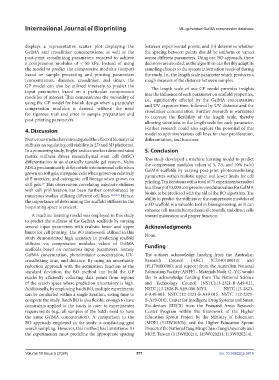Page 579 - IJB-10-5
P. 579
International Journal of Bioprinting ML-generated GelMA compression database
displays a representative scatter plot displaying the between experimental points, and (ii) determine whether
GelMA and crosslinker concentrations, as well as the the spacing between points should be uniform or varied
post-print crosslinking parameters required to achieve across different parameters. Using our BO approach, these
a compression modulus of < 50 kPa. Instead of using decisions are avoided, as the algorithm can flexibly adapt its
the model to predict the compressive modulus (output) sampling choices to the system information received during
based on sample processing and printing parameters the study, i.e., the length scale parameter which produces a
(concentration, distance, crosslinker, and time), the rough measure of the distance between samples.
GP model can also be utilized inversely to predict the The length scale of our GP model provides insights
input parameters based on a particular compression into the influence of each parameter on scaffold properties,
modulus of interest. This demonstrates the versatility of i.e., significantly affected by the GelMA concentration
using the GP model for bioink design when a particular and UV exposure time, followed by UV distance and the
compression modulus is desired, without the need crosslinker concentration. Further research is warranted
for rigorous trial and error in sample preparation and to increase the flexibility of the length scale, thereby
post-printing parameters.
allowing variations in the length scale for each parameter.
4. Discussion Further research could also explore the potential of this
model to optimize various cell lines for their proliferation,
Numerous studies have investigated the effect of biomaterial differentiation, and function.
stiffness on regulating cell viability in 2D and 3D platforms.
In a pioneering study, Engler and co-workers demonstrated 5. Conclusion
matrix stiffness drives mesenchymal stem cell (MSC) This study developed a machine learning model to predict
differentiation in an elastically tunable gel system. Naive the compression modulus values of 5, 7.5, and 10% (w/v)
MSCs predominantly differentiate into neuronal cells when GelMA scaffolds by varying post-print photocrosslinking
grown on soft gels, myogenic cells when grown on relatively parameters within realistic upper and lower limits for cell
stiff matrices, and osteogenic cell lineage when grown on printing. Ten iterations with a total of 75 experiments resulted
stiff gels. This observation correlating substrate stiffness in a library of 13,000 compression modulus values for GelMA
29
with cell proliferation has been further corroborated by bioink to be predicted with the aid of the BO algorithm. The
numerous studies utilizing different cell lines. 18,30,31 Hence, ability to predict the stiffness or the compressive modulus of
the importance of determining the scaffold stiffness in the a 3D scaffold is a valuable tool in bioengineering, as it can
bioprinting space is evident.
enhance cell-matrix biomechanical crosstalk and direct cells
A machine learning model was employed in this study toward maturation and proper function.
to predict the stiffness of the GelMA scaffolds by varying
several input parameters with realistic lower and upper Acknowledgments
limits for cell printing. The BO framework utilized in this None.
study demonstrated high accuracy in predicting scaffold
stiffness via compression modulus values of GelMA Funding
scaffolds based on numerous input parameters, namely
GelMA concentration, photoinitiator concentration, UV- The authors acknowledge funding from the Australian
crosslinking time, and distance. By using an uncertainty Research Council (ARC) (CE140100012) and
reduction approach with the acquisition function as the (FL170100006), and support from the Australian National
standard deviation, the BO method can build the GP Fabrication Facility (ANFF) – Materials Node. G.-Y.C. would
model by efficiently collecting data points from regions like to acknowledge funding from The National Science
of the search space where prediction uncertainty is high. and Technology Council (NSTC113-2321-B-A49-021,
Additionally, by employing batch BO, multiple experiments NSTC113-2628-B-A49-008-MY3, NSTC113-2823-
can be conducted within a single iteration, saving time to 8-A49-003, NSTC112-2321-B-A49-015, NSTC 112-2321-
complete the study. Batch BO is also flexible enough to have B-A49-016), Center for Intelligent Drug Systems and Smart
constraints applied to the batch to cater to experimenter Bio-devices (IDS B) from the Featured Areas Research
2
requirements (e.g., all samples of the batch need to have Center Program within the framework of the Higher
the same GelMA concentration). A comparison to the Education Sprout Project by the Ministry of Education
BO approach employed in the study is conducting grid (MOE) (113W30305), and the Higher Education Sprout
search sampling. However, this method has limitations: (i) Project of the National Yang Ming Chiao Tung University and
the experimenter must predefine the appropriate spacing MOE, Taiwan (113W020211, 113W020211, 113W020214).
Volume 10 Issue 5 (2024) 571 doi: 10.36922/ijb.3814

